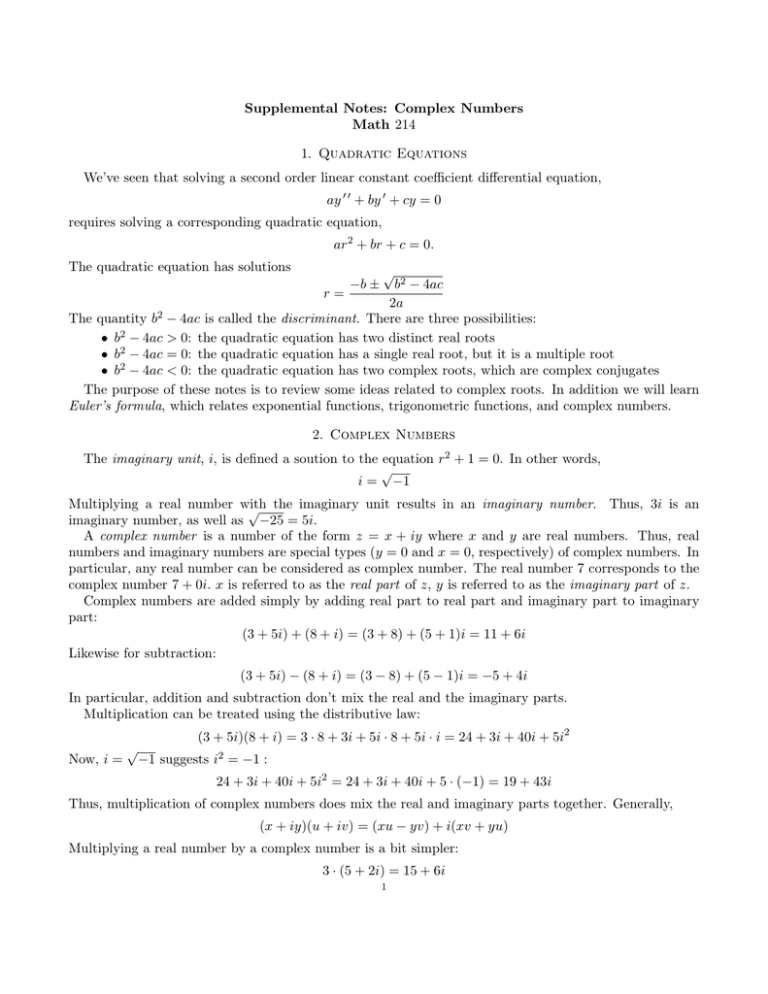Supplemental Notes: Complex Numbers Math 214 1. Quadratic Equations
advertisement

Supplemental Notes: Complex Numbers Math 214 1. Quadratic Equations We’ve seen that solving a second order linear constant coefficient differential equation, ay 0 0 + by 0 + cy = 0 requires solving a corresponding quadratic equation, ar2 + br + c = 0. The quadratic equation has solutions √ b2 − 4ac 2a The quantity b2 − 4ac is called the discriminant. There are three possibilities: • b2 − 4ac > 0: the quadratic equation has two distinct real roots • b2 − 4ac = 0: the quadratic equation has a single real root, but it is a multiple root • b2 − 4ac < 0: the quadratic equation has two complex roots, which are complex conjugates The purpose of these notes is to review some ideas related to complex roots. In addition we will learn Euler’s formula, which relates exponential functions, trigonometric functions, and complex numbers. r= −b ± 2. Complex Numbers The imaginary unit, i, is defined a soution to the equation r2 + 1 = 0. In other words, √ i = −1 Multiplying a real number with √ the imaginary unit results in an imaginary number. Thus, 3i is an imaginary number, as well as −25 = 5i. A complex number is a number of the form z = x + iy where x and y are real numbers. Thus, real numbers and imaginary numbers are special types (y = 0 and x = 0, respectively) of complex numbers. In particular, any real number can be considered as complex number. The real number 7 corresponds to the complex number 7 + 0i. x is referred to as the real part of z, y is referred to as the imaginary part of z. Complex numbers are added simply by adding real part to real part and imaginary part to imaginary part: (3 + 5i) + (8 + i) = (3 + 8) + (5 + 1)i = 11 + 6i Likewise for subtraction: (3 + 5i) − (8 + i) = (3 − 8) + (5 − 1)i = −5 + 4i In particular, addition and subtraction don’t mix the real and the imaginary parts. Multiplication can be treated using the distributive law: Now, i = √ (3 + 5i)(8 + i) = 3 · 8 + 3i + 5i · 8 + 5i · i = 24 + 3i + 40i + 5i2 −1 suggests i2 = −1 : 24 + 3i + 40i + 5i2 = 24 + 3i + 40i + 5 · (−1) = 19 + 43i Thus, multiplication of complex numbers does mix the real and imaginary parts together. Generally, (x + iy)(u + iv) = (xu − yv) + i(xv + yu) Multiplying a real number by a complex number is a bit simpler: 3 · (5 + 2i) = 15 + 6i 1 2 The complex conjugate of a complex number is obtained by changing the sign of the imaginary part: Complex conjugate of 3 + 8i is 3 − 8i An important fact about conjugate complex numbers is that their product is a nonnegative real number. For example, (3 + 8i)(3 − 8i) = (3 · 3 + 8 · 8) + (3 · 8 − 3 · 8)i = 73 Also, their sum is a real number. For example, (3 + 8i) + (3 − 8i) = (3 + 3) + (8 − 8)i = 6 Example: Lets find the roots of the quadratic equation r2 + r + 1 = 0 Using the quadratic formula, we find √ √ 12 − 4 · 1 · 1 1 3 r= =− ± i 2 2 2 The roots are complex conjugates of each other, √ √ 1 1 3 3 r=− + i, r=− − i 2 2 2 2 In fact, if the quadratic equation ar2 + br + c = 0 has b2 − 4ac < 0, then both roots of the quadratic equation are complex and the roots are complex conjugates of each other. Division of complex numbers can be a bit cumbersome. First, we show how to simplify the reciprocal of a complex number. 1 1 1−i 1−i 1−i 1 1 = · = = = −i 1+i 1+i 1−i (1 + i)(1 − i) 2 2 2 −1 ± Now to divide two complex numbers, we first write the division as multiplication by a reciprocal, then simplify the reciprocal as above, then treat the problem as multiplying two complex numbers: 3+i 1 1 1 = (3 + i) · = (3 + i)( − i ) = 2 − i 1+i 1+i 2 2 3. Euler’s Formula Exponential functions measure growth and decay. Trigonometric functions measure oscillation. These appear to be two totally unrelated phenomena. Euler was the first to realize that oscillating functions arise as growth or decay in the complex plane: eit = cos t + i sin t Here, t is assumed to be a real number. More generally, ex+iy = ex eiy = ex (cos y + i sin y) = ex cos y + iex sin y Euler’s fomula can be rearranged to express trigonemtric functions in terms of complex exponentials: eit − e−it eit + e−it sin t = 2 2i The law of exponents continues to hold for imaginary powers: cos t = ei(α+β) = eiα eiβ 3 Rewritting this using Euler’s formula and multiplying out yields something interesting: The left hand side is cos (α + β) + i sin (α + β) whereas the right hand side is (cos α + i sin α)(cos β + i sin β) = (cos α cos β − sin α sin β) + i(cos α sin β + sin α cos β) Equating real part to real part and imaginary part to imaginary part reveals that the sine and cosine addition identities are just consequences of the law of exponents. In fact, almost all of the identities you learned in trigonemtry can be recovered using Euler’s formula. Examples of using Euler’s formula: π • Simplify ei 6 e i π6 = cos π 6 + i sin π 6 √ = 3 1 + i 2 2 • Write 32i in the form x + iy. First, 3t = et ln 3 for any t, and so 32i = ei(2 ln 3) = cos (2 ln 3) + i sin (2 ln 3) • Simplify eiπ eiπ = cos π + i sin π = 1 + 0 · i = 1 This rearranges to ei·π − 1 = 0, which relates the five most fundamental mathematical constants, 0, 1, e, π, and i. • Simplify e3−5i e3+5i = e3 e5i = e3 (cos 5 + i sin 5) 4. The Point of This Euler’s formula leads to some very beautiful mathematics, but the real advantage for us is that it gives a single framework for working with differential equations of the form ay 00 + by 0 + cy = 0 regardless of if the characteristic equation has postive or negative discriminant. At the beginning of Chapter 3 we considered harmonic oscillator equations like y 00 + y = 0 whose general solution was y = α cos t + β sin t. In Chapter 3.1 we considered equations like y 00 − y = 0 whose general solution was y = Aet + Be−t . Given a constant coefficient linear second order differential equation, when should we look exponential solutions and when should we look for trigonometric solutions? Euler’s formula unifies exponential and trigonometric functions, so it is enough to just focus on finding exponential solutions. 4 Thus, lets seek solutions of the form y = ert to the harmonic oscillator. The characteristic equation is r2 + 1 = 0 so r = ±i, and so the general solution should be of the form y = Aeit + Be−it Using Euler’s formula, y = A(cos t + i sin t) + B(cos t − i sin t) = (A + B) cos t + i(A − B) sin t Thus, the coefficients α and β in y = α cos t + β sin t are related to the coefficients in y = Aeit + Be−it through α=A+B β = i(A − B) This point of view is even more useful when we consider a harmonic oscillator in the presence of friction. A perfect example of this is a vibrating guitar string. Over an extremely breif period the string can be modelled as a simple harmonic oscillator. But in the long run the amplitude of the vibration decays. The motion involves both a decaying part and an oscillating part. Consider 2y 00 + 2y 0 + y = 0 The characteristic equation is 2r2 + 2r + 1 = 0 which has solutions 1 1 −2 ± 2i =− ±i r= 4 2 2 The general solution is then 1 1 1 1 y = c1 e(− 2 +i 2 )t + c2 e(− 2 −i 2 )t This can be written as 1 1 1 1 1 1 1 c1 e− 2 t ei 2 t + c2 e− 2 t e−i 2 t = e− 2 t c1 ei 2 t + c2 e−i 2 t But t t c1 e + c2 e = (c1 + c2 ) cos + (c1 − c2 ) sin 2 2 Thus, the motion of this damped harmonic oscillator is t t − 21 t y=e A cos + B sin 2 2 for appropriate constants A and B. This is the way the solution to a damped harmonic oscillator is usually written, in that the complex exponentials are broken into a real exponential times a combination of sines and cosines. Notice the real parts of the roots of the characteristic equation determine how quickly the vibration dies out and the imaginary parts of the roots of the characteristic equation determine the frequency of the oscillation. i 12 t −i 21 t





